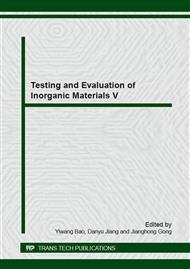[1]
L.H. Huang, J.J. Kong, W.L. Wang, C.L. Zhang, S.F. Niu, B.Y. Gao. Study on Fe(III) and Mn(II) modified activated carbons derived from Zizania latifolia to removal basic fuchsin. Desalination. 286(2012) 268–276.
DOI: 10.1016/j.desal.2011.11.034
Google Scholar
[2]
V.K. Gupta, A. Mittal, V. Gajbe, J. Mittal. Adsorption of basic fuchsin using waste materials - bottom ash and deoiled soya - as adsorbents. J. Colloid Interf. Sci. 319(2008) 30–39.
DOI: 10.1016/j.jcis.2007.09.091
Google Scholar
[3]
Y. Wang, X.W. Tang, Y.M. Chen, L.T. Zhan, Z.Z. Li, Q. Tang. Adsorption behavior and mechanism of Cd(II) on loess soil from China. J. Hazard. Mater. 172(2009) 30–37.
DOI: 10.1016/j.jhazmat.2009.06.121
Google Scholar
[4]
Y.F. He, L. Zhang, R.M. Wang, H.R. Li, Y. Wang. Loess Clay Based Copolymer for Removing Pb(II) Ions. J. Hazard. Mater. 227–228(2012) 334–340.
DOI: 10.1016/j.jhazmat.2012.05.071
Google Scholar
[5]
W.J. He, Y.F. He, D.Z. Yan, Y. Wang, R. M. Wang. Adsorption of Lead Ion using Polymer Modified Wheat Straw Carboxymethylcellulose. J. Dispersion Sci. Techn. DOI: 10. 1080/01932691. 2013. 845104.
DOI: 10.1080/01932691.2013.845104
Google Scholar
[6]
V.V. Panic, S.J. Velickovic. Removal of model cationic dye by adsorption onto poly(methacrylic acid)/zeolite hydrogel composites: Kinetics, equilibrium study and image analysis. Sep. Purif. Technol. 122(2014) 384–394.
DOI: 10.1016/j.seppur.2013.11.025
Google Scholar
[7]
R. Darvishi Cheshmeh Soltani, A.R. Khataee, M. Safari, S.W. Joo. Preparation of bio-silica/chitosan nanocomposite for adsorption of a textile dye in aqueous solutions. Int. Biodeter. Biodege. 85(2013) 383-391.
DOI: 10.1016/j.ibiod.2013.09.004
Google Scholar
[8]
Y. N. Patel, M. P. Patel. Adsorption of azo dyes from water by new poly (3-acrylamidopropyl)-trimethylammonium chloride-co-N, N-dimethylacrylamide superabsorbent hydrogel—Equilibrium and kinetic studies. J. Environ. Chem. Eng. 1( 2013)1368-1374.
DOI: 10.1016/j.jece.2013.09.024
Google Scholar


